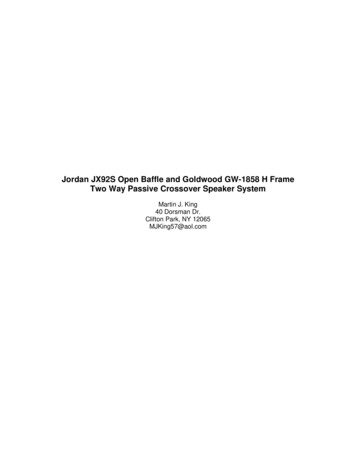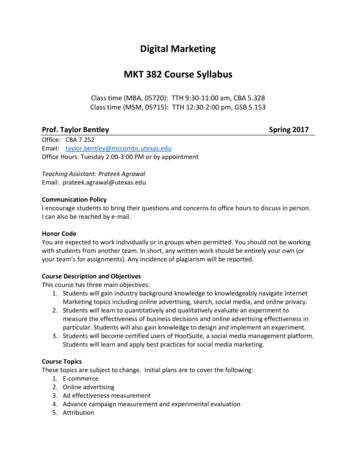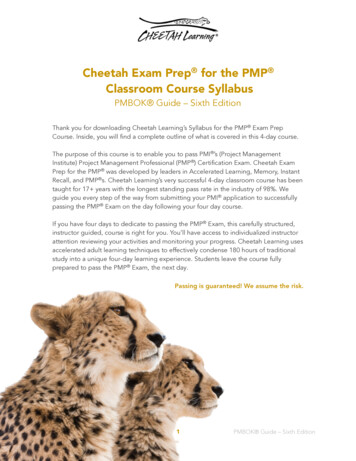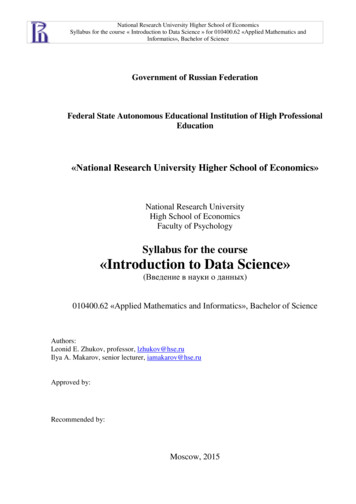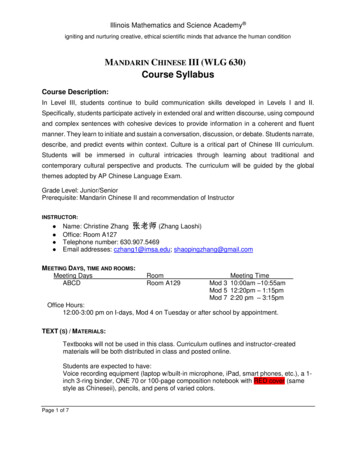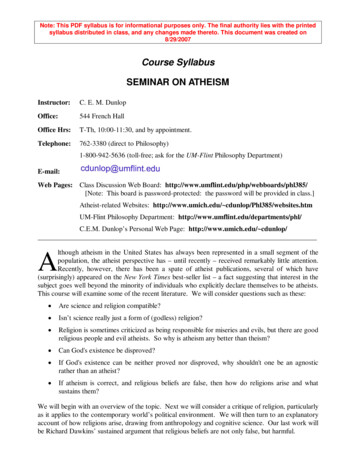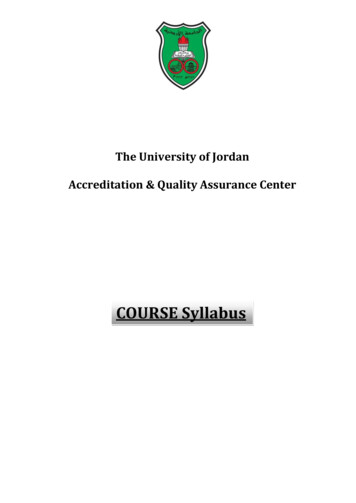
Transcription
The University of JordanAccreditation & Quality Assurance CenterCOURSE Syllabus
The University of JordanCourse SyllabusAccreditation and Quality Assurance Center1Course titlePattern Recognition2Course numberCredit hours (theory, practical)Contact hours (theory, er Graphics (1901359)5Program titleB.Sc. in Computer Science6Program code017Awarding institutionThe University of Jordan8FacultyKing Abdullah II School for Information Technology9DepartmentComputer Science10Level of course4th year11Year of study and semester (s)Second Semester (Spring) 2014/201512Final QualificationOther department (s) involved inteaching the courseNone14Language of InstructionEnglish15Date of production/revision1/201516Required/ ElectiveElective3133316. Course Coordinator:Computer Science Department, Office no. 113, 1st floorPhone: 9625355000. Extension: 22578Email: hazemh@ju.edu.joOffice hours: 12-1 (Sun, Tue, Thu), 8-9:30 (Mon)17. Other instructors:None18. Course Description:This course covers pattern recognition essentials with topics that are suitable for undergraduate levels in computerscience and most engineering specialties. It covers wide understanding of different related topics, i.e., patternrecognition systems, preprocessing and feature extraction, theories of supervised and unsupervised learning, objectclassification and recognition, artificial neural networks, and other topics as well.1
The University of JordanCourse SyllabusAccreditation and Quality Assurance Center19. Course aims and outcomes:A- Aims:The main goal of this course is to teach students the foundations of pattern recognition, i.e. how patterns arerecognized on the computer. The course aims to provide you with sufficient background in the theoretical conceptsbehind stages of pattern recognition systems, and to implement these systems using computer applications.Objectives include enabling students to:1.Learn about pattern recognition and its broad applications in various aspects of our day to day life.2.Understand the algorithms used in various phases of pattern recognition systems, including data acquisition,pre-processing, segmentation, feature extraction and classification.3.Understand the techniques used recognize patterns, such as statistical approaches, data clustering, neuralnetworks, etc.4.Knowledge of various applications of pattern recognition in real life, this includes reading research papersand preparing presentations by the students.5.Writing pattern recognition programs and implement the various techniques discussed throughout thecourse.B- Intended Learning Outcomes (ILOs): Upon successful completion of this course students will be able to A- Knowledge and Understanding: Students should A1) Learn the concepts of pattern recognition, including its definition, design cycle, applications,algorithms.A2) Know the important principles of neural networks.A3) Understand the basic concepts involved in structural and statistical pattern recognitionB- Intellectual skills: with the ability to B1) Compare and analyze algorithms used in pattern recognition.B2) Apply mathematical tools to algorithm design.B3) Analytically recognize pattern recognition systemsC- Subject specific skills – with ability to C1) Understand various techniques used in object detection and classification.C2) Understand various techniques used in pattern recognition systems, including supervised andunsupervised learning.C3) Translate abstract ideas into practice.D- Transferable skills – with ability toD1) Possess good programming style.D2) Possess the ability to read research papers.D3) Possess the ability for oral presentations.2
The University of JordanCourse SyllabusAccreditation and Quality Assurance Center20. Topic Outline and Schedule (T: Teaching, L: Learning, A: Assessment):TopicIntroduction: definition, systems,and applicationsWeekInstructorAchievedILOs1 2Dr Hazem HiaryA1, A33Dr Hazem HiaryA1, A2, A34Dr Hazem HiaryA2, B1, B3,C2Neural networks: Hopfieldnetwork: structure, example, code.Neural networks training4 5Dr Hazem HiaryA2, B1, B2,C2, D1Neural networks: feedforwardbackpropagation: structure,example, code. Neural networkspruning: definition and algorithmsMidterm examHough transform: definition,algorithms, code6Dr Hazem HiaryA2, B2, C2,C3, D178Dr Hazem HiaryDr Hazem HiaryObject recognition: detection ofobjects, with examples and code9Dr Hazem HiaryA2, B1, B3,C1, D1Data clustering: definition,unsupervised learning, algorithms,examples and code10Dr Hazem HiaryA1, B1, C2,C3, D1Classification: definition andalgorithms, k-nearest neighboralgorithm with examples and code11Dr Hazem HiaryA1, B2, B3,C2, D1Template matching: definition,algorithms, with examples andcode12Dr Hazem HiaryA1, B2, C2,C3, D113-14Dr Hazem HiaryA1, D1,D2, D3Review15Dr Hazem HiaryFinal Exam16Dr Hazem HiaryNeural networks: history,definition, structure, supervisedlearningNeural networks: structure:weights and activation functions,examples, matrix operationsPresentations3A1, B1, C1,C2, D1Evaluation MethodsT: Lecture and presentationL: Reading lecture notesA: in class questionsT: Lecture and presentationL: Reading lecture notesA: in class questionsT: Lecture and presentationL: Reading lecture notes,examplesA: in class questionsT: Lecture and presentationL: Reading lecture notes,examples, codeA: in class questionsT: Lecture and presentationL: Reading lecture notes,examples, codeA: in class questionsA: Written exam - Weeks 1- 6T: Lecture and presentationL: Reading lecture notes,examples, codeA: in class questionsT: Lecture and presentationL: Reading lecture notes,examples, codeA: in class questionsT: Lecture and presentationL: Reading lecture notes,examples, codeA: in class questionsT: Lecture and presentationL: Reading lecture notes,examples, codeA: in class questionsT: Lecture and presentationL: Reading lecture notes,examples, codeA: in class questionsT: Presentations by studentsL: PresentationA: in class oral presentationsT: Summary and ReviewL: DemoA: Sample of examsWritten exam – Weeks 1 - 15
The University of JordanCourse SyllabusAccreditation and Quality Assurance Center21. Teaching Methods and Assignments:Teaching (T) Strategies: The class contact is 3 hours per week. The course will be delivered using different meanslike lectures, presentations, demonstration examples, and discussions.Learning (L) Methods: Students attend classes, ask questions and participate in discussions, do the homework,present and demo their work. Students will use the lab to implement the practical parts. Students will access the elearning platform for more instructions and supported learning materials.Assessment (A) Methods: There will be several assessment methods of evaluating the performance of thestudents such as attending and class participation, grading the quizzes; conducting the Midterm and the FinalExams.22. Evaluation Methods and Course Requirements:Mid-Term Exam30%Presentation20%Final Exam50%23. Course Policies:Please follow The University of Jordan regulations regarding the following policies, more information is atwww.ju.edu.joA- Attendance policiesB- Absences from exams and handing in assignments on timeC- Health and safety proceduresD- Honesty policy regarding cheating, plagiarism, misbehaviorE- Grading policyF- Available university services that support achievement in the course24. Required equipment:A computer so that students can practice theoretical material and programming using MATLAB, C#, C 25. References: Pattern Classification, Duda, Hart, and Strok, Wiley, latest edition. Pattern recognition, Theodoridis, Sergios, Koutroumbas, Konstantinos, Elsevier, latest edition. Pattern Recognition and Machine Learning, Bishop, Springer, 2006. Introduction to Neural Networks for C#, , Heaton, Jeff, Heaton research, 2nd edition, 2008.4
The University of JordanCourse SyllabusAccreditation and Quality Assurance CenterRecommended materials, and media: Pattern recognition video lectures:o http://videolectures.net/Top/Computer Science/Machine Learning/Pattern Recognition/o https://www.youtube.com/results?search query pattern recognition26. Additional information:NoneName of Course Coordinator: -------------------Signature: ------------------------- Date: ------------------------Head of curriculum committee/Department: ------------------------- Signature: --------------------------------Head of Department: ------------------------- Signature: --------------------------------Head of curriculum committee/Faculty: ------------------------- Signature: --------------------------------Dean: ------------------------------------------- -Signature: ---------------------------------Copy to:Head of DepartmentAssistant Dean for Quality AssuranceCourse File5
The University of Jordan Course Syllabus Accreditation and Quality Assurance Center 2 19. Course aims and outcomes: A- Aims: The main goal of this course is to teach students the foundations of pattern recog
